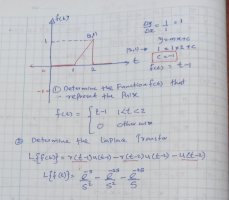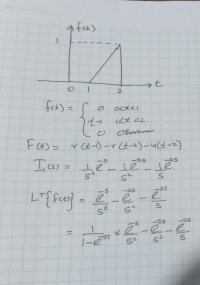You are using an out of date browser. It may not display this or other websites correctly.
You should upgrade or use an alternative browser.
You should upgrade or use an alternative browser.
Please check if any errors in Laplace transform of my answer: f(t) = 0, 0<x<1; t-1, 1<x<2; 0 otherwise
- Thread starter PA3040D
- Start date
I also do not have big idea, about but I followed following YouTube video which was explaining in the end of the video . Please check if you have free timeCorrect. But I don't understand the purpose of the last step!
Thanks in advanced
This video is talking about periodic signal. Your problem in post #1 is not periodic. Therefore, dividing by [imath]1 - e^{-2s}[/imath] is wrong.
Forget the video and start over again. The first step to solve your problem is by changing the function [imath]f(t)[/imath] from a piecewise form to a new form in terms of the unit step function. Do you know how to do that?
Forget the video and start over again. The first step to solve your problem is by changing the function [imath]f(t)[/imath] from a piecewise form to a new form in terms of the unit step function. Do you know how to do that?
Last edited:
As far as I understand, the answer will be this. Please advise what will happen to the contents of the red-colored box during the conversion to Laplace.This video is talking about periodic signal. Your problem in post #1 is not periodic. Therefore, dividing by [imath]1 - e^{-2s}[/imath] is wrong.
Forget the video and start over again. The first step to solve your problem is by changing the function [imath]f(t)[/imath] from a piecewise form to a new form in terms of the unit step function. Do you know how to do that?

If you will write this notation:
[imath]\displaystyle f(t) = \gamma(t-1) \ u(t-1) - \gamma(t-2) \ u(t-2) - u(t-2)[/imath],
you should define [imath]\displaystyle \gamma(t) = t[/imath]
Otherwise, you should write the normal notation directly as:
[imath]\displaystyle f(t) = (t-1) \ u(t-1) - (t-2) \ u(t-2) - u(t-2)[/imath]
And
[imath]\displaystyle \mathcal{L}\{\gamma(t - 2) \ u(t - 2)\} = \mathcal{L}\{\gamma(t)\} \ e^{-2s}[/imath]
[imath]\displaystyle f(t) = \gamma(t-1) \ u(t-1) - \gamma(t-2) \ u(t-2) - u(t-2)[/imath],
you should define [imath]\displaystyle \gamma(t) = t[/imath]
Otherwise, you should write the normal notation directly as:
[imath]\displaystyle f(t) = (t-1) \ u(t-1) - (t-2) \ u(t-2) - u(t-2)[/imath]
[imath]\displaystyle \mathcal{L}\{\gamma(t - 1) \ u(t - 1)\} = \mathcal{L}\{\gamma(t)\} \ e^{-s}[/imath]As far as I understand, the answer will be this. Please advise what will happen to the contents of the red-colored box during the conversion to Laplace.
View attachment 38063
And
[imath]\displaystyle \mathcal{L}\{\gamma(t - 2) \ u(t - 2)\} = \mathcal{L}\{\gamma(t)\} \ e^{-2s}[/imath]
Dear experts, I would greatly appreciate it if someone could review my question and answer. Please let me know if my answer is correct, or if it is wrong, please point out the errors. Thank you.
Part 1) Determine the function F(t) that represent the pulse
Part 2) Determine the Laplace transform of the pulse

Part 1) Determine the function F(t) that represent the pulse
Part 2) Determine the Laplace transform of the pulse

This is the same problem that we have solved before!Dear experts, I would greatly appreciate it if someone could review my question and answer. Please let me know if my answer is correct, or if it is wrong, please point out the errors. Thank you.
Part 1) Determine the function F(t) that represent the pulse
Part 2) Determine the Laplace transform of the pulse
View attachment 38068
OMG SorryThis is the same problem that we have solved before!


